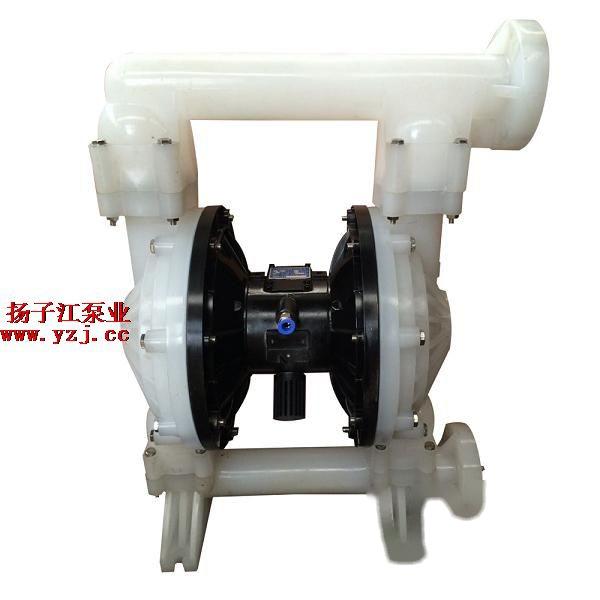The QBY type pneumatic diaphragm pump is a novel pump in China, capable of transferring various corrosive liquids, as well as liquids that contain particles, are high-viscosity, volatile, flammable, explosive, or highly toxic, such as ceramic glaze slurry, fruit pulps, glues, oil recovery from tankers, temporary tank emptying, and more. The pump body is made of materials such as stainless steel, aluminum alloy, cast iron, and engineering plastics, while the diaphragm is made from nitrile rubber, fluorine rubber, neoprene, polytetrafluoroethylene, and perfluoroalkoxy (F46) based on the type of liquid being handled.
The QBY series pneumatic diaphragm pump uses compressed air, steam, or industrial waste gas as the power source, with a suction lift of up to 7m, a head of 0-50m, and a flow rate of 0.8-40 m3/h that is infinitely adjustable.
Engineering plastic diaphragm pump product features
1. No shaft seals, no leakage, and a wide flow path, which means that when transporting media containing particles, high viscosity (up to 10,000 centipoise), volatile, and corrosive substances, it will not cause environmental pollution or endanger personal safety.
2. No rotating parts, good performance, allows for large particle diameters up to 10mm. The liquid flows without shear, resulting in minimal wear on the pump's components. It causes little damage to the transported materials, allowing for the transfer of sludge and living organisms such as fry.
3. No need for priming, strong self-priming capability with a suction lift of up to 7m, and prolonged dry running does not damage the pump. If overloaded, the pump will automatically shut down, and it can restart automatically when the load returns to normal, providing a self-protection function (electric pumps do not have this feature).
4. The pneumatic pump has a head of up to 50m, while the electric pump reaches 30m, with an outlet pressure of up to 0.6mpa. The head and flow rate can be infinitely adjusted by changing the air valve opening, and the air pressure can be adjusted between 1-7 kgf/cm2. Electric pumps do not have this capability and require a regulating valve for control at the inlet.
5. The pneumatic pump can work submerged in the media without needing a power supply, making it safe and reliable (electric pumps do not have this capability).
6. The pneumatic pump does not require a power supply, making it more suitable for transporting media in flammable and explosive environments.
Engineering plastic diaphragm pump performance parameters
| Model |
Flow Rate (m 3 /h) |
Head (m) |
Outlet Pressure (kgf/cm 2) |
Suction Lift (m) |
Max Allowed Particle Diameter (mm) |
Max Supply Pressure (kbf/cm 2) |
Max Air Consumption (m 3 /min) |
Materials | |||
| Aluminum Alloy | Stainless Steel | Cast Iron | Reinforced Polypropylene | ||||||||
| QBY-10 | 0~0.8 | 0~50 | 5 | 5 | 1 | 7 | 0.3 | ★ | ★ | ★ | ★ |
| QBY-15 | 0~1 | 0~50 | 5 | 5 | 1 | 7 | 0.3 | ★ | ★ | ★ | ★ |
| QBY-25 | 0~2.4 | 0~50 | 5 | 7 | 2.5 | 7 | 0.6 | ★ | ★ | ★ | ★ |
| QBY-40 | 0~8 | 0~50 | 5 | 7 | 4.5 | 7 | 0.6 | ★ | ★ | ★ | ★ |
| QBY-50 | 0~12 | 0~50 | 5 | 7 | 8 | 7 | 0.9 | ★ | ★ | ★ | ★ |
| QBY-65 | 0~16 | 0~50 | 5 | 7 | 8 | 7 | 0.9 | ★ | ★ | ★ | ★ |
| QBY-80 | 0~24 | 0~50 | 5 | 7 | 10 | 7 | 1.5 | ★ | ★ | ★ | ★ |
| QBY-100 | 0~30 | 0~50 | 5 | 7 | 10 | 7 | 1.5 | ★ | ★ | ★ | ★ |













